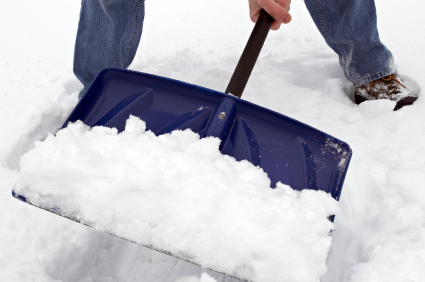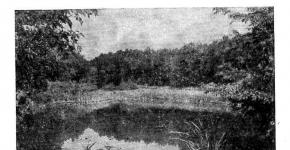How to remove snow. How to clean your yard from snow
Having their own, even a small plot of land, the owners are faced with such a problem as the constant care of it. Especially you need to pay attention to the yard in winter, when a lot of snow falls. Because if you do not clean your yard from snow in time, it will begin to condense and form into an ice cover.
The snow does not ask when, and in what quantity it should fall, in such a case the experienced owner always has the means to clean the territory. It is especially upsetting when we wake up in the morning rushing to work, barely have time to drink a cup of coffee, and going out into the yard, we notice that absolutely everything is littered with snow. First, you should get used to holding a snow shovel near the front door. If you have a car, then you are familiar with the problem that it can sweep the car with snow and then it is impossible to get to it. To avoid such unpleasant situations - get used to always clear the track, the width of a shovel, to the car. If you do not have a garage, then an awning can be a good alternative.
The scheme of clearing the yard of snow
In order to properly clean the snow, you need to rinse the cleaned places with a broom or brush after shoveling. Most owners have paving stones in the yard. With its cleaning there will be no problems. So that the snow does not notice much of the yard, certain designs are made, but in order to install it correctly, you need to order a visualization of your yard, if you do not already have it. After installing snow retainers for snow, it will be easier and more convenient for you to clean it.
So, to do everything perfectly, you need to do the following things:
Every time when the next batch of snow falls - immediately remove it. If you have a city, then just throw it onto the city from the tracks. Repeat this procedure with all the tracks that are present in your yard.
Be sure to clean the snow around your home. This is done so that the snow does not begin to melt and does not wash the foundation of the house. After cleansing the snow with a shovel - walk with a brush, then once again remove the fine snow with a shovel.

If you didn’t have time to remove the snow on time, and it lay down for a couple of days, an ice cover forms. To remove ice - you need to take a small ax and lightly tap on the ice until it breaks, then remove the fragments. Option two - sprinkle with salt. Everyone knows that salt corrodes ice, but this method should be used only if you do not have paving stones. If salt is sprinkled on the paving stones, it may crack. In the case of paving stones, sand will help you. Just sprinkle with sand those places where you walk, and there will be no slippery.
19.08.2014
Instruction manual
The most primitive option for removing snow from a summer cottage is a shovel. For a snowdrift that has compacted after a thaw, a wooden or plastic shovel will not work. You just can’t stick it in the snow. An iron shovel with a tip is the most for a solid snowdrift. After you split the snowdrift into smaller parts, you can scatter them already with an ordinary snow shovel. Throw it to “warm places” where last year’s grass is already visible. In these places, the snow will quickly melt and evaporate. After a few days, you will notice that there is practically no snow left.
Everyone knows that in the "black" bake. This applies not only to people and their clothes, but also to nature. To snow melted more actively, sprinkle snowdrifts with ash or small peat over the entire area. Then the daytime sun, which is already warming so that it is getting hot, will quickly cope with its task. Moreover, peat and ash are useful for the garden. Yes, and they will not harm the lawn in front of the house. These natural fertilizers will simply go to the ground along with melt water.
The same effect as dark fertilizers gives a black film. If you need to melt a small area, then you can cover the place with a black film for several days. The greenhouse effect that forms under cover quickly melts the snow. Perhaps the colorless film can handle it, but the black tint collects more solar energy.
A more dangerous way to remove snow in the yard is salt or other reagents. If strong reagents are not so easy to find in stores, then ordinary edible salt will successfully replace them with you. Why is salt dangerous? Because she, in addition to the active processing of solid snow into dirty porridge, will eat your boots. Yes, the sole from the boots can greatly deteriorate from interacting with salts. Therefore, after sprinkling snow with a reagent, it is advised not to walk on it for some time. And when you notice that the snow has softened and is ready for harvesting, then rather pick up a shovel in your hands and scoop up the porridge away from people's feet. Better for the plot. Where no one walks and nothing useful grows. Because salt acts negatively on the soil.
note
Peat and dark film can be found in hardware stores. They are inexpensive, so everyone can afford them for themselves.
Ash can be scattered before each flooding of the country bath during the year, you can also collect it in a separate container, and in the spring fill it with the whole garden.
Useful advice
It is better not to use salt in a summer cottage. It is a very active reagent that corrodes the soles of shoes and garden paths. And also kills all life in the earth.
Cleaning the area with a shovel is excellent physical education for a weekend.
The advent of the winter season delights adults and children, recalling the approaching New Year and Christmas holidays. The main winter attribute is, of course, snow, which everyone eagerly awaits to enjoy winter fun. Children make snowmen and sledding, adults go skiing and snowboarding. However, not all the inhabitants of the planet were so lucky that they could enjoy the snow throughout the winter. In some places, the first snow falls in November, and in some places it becomes the last at the same time.
Where and how does that huge amount of snow that falls in winter disappear? The snow melts, that is, turns into water and simply evaporates, obeying the laws of physics. But many have another question: why does dirty snow melt much faster than clean snow? In this regard, people constantly see dirt and water on the roads where cars drive. For the same reason, in cities usually snow quickly disappears in the winter, and in the forest it lies for a long time. Of course, snow is constantly being cleaned up in the city, but this is not the only reason.
Here again the laws of physics come to the rescue, which can explain this mysterious phenomenon for many. As you know, objects of dark colors attract heat more and absorb it, unlike light ones. Now switch to the snow. White snow, so brilliantly sparkling in the sun, actually practically does not undergo its influence and does not respond to heat. White color reflects the sun's rays, and the snow remains lying on the ground, pleasing the eyes of children and adults. Naturally, this only happens if the air temperature is below zero. In this case, the sun only adorns the snow, but does not destroy it.
Now imagine dirty snow. Snow cleaning in cities is not so frequent, so residents have to feel the melting process on themselves. And this happens for one simple reason. Snow, which gets dirt from cars or pedestrians, becomes dark in color and begins to absorb the heat that the sun gives it. Under its influence, such snow actively melts, turning into dirt, which many do not like so much. As you can see, the whole thing is only in the laws of nature and physical propertiesthat endowed with snow. That is why on the roads the mountains of snow quickly turn into slush, and the paths trodden by passers-by are exposed, after which the snow disappears.
Related videos
Snow in our latitudes is not something exotic. And this is wonderful, because what is winter without snow? Snow covers the garden with a white veil, giving it a fabulous look. This is useful for the garden, because plants under the snow better tolerate winter cold.
The real owner is always ready for the appearance of snow. This is not a problem for him, because he had previously prepared a shovel for cleaning snow from the tracks and prepared the plants for winter.
Snow on the plants.
A lot of snow can damage some plants. Under its heavy weight, the branches are deformed, bent, and if the snow is wet, then they break. But you should not be afraid of this, as it can be prevented. After and in time of snowfall from the trees and shrubs, it is enough to periodically shake off the snow. If you do not have enough time for this, then you can pre-tie their crowns with a rope. This of course applies to small trees, shrubs and coniferous shrubs with a columnar shape.
As for lawns, perennials and low shrubs, here it is just the opposite, snow contributes to a better wintering. But a very thick dense layer of snow can harm them, because under such a “pie” the plants will feel a lack of oxygen and may suffocate. It also affects their development in the spring, after the snow melts, because the snow will melt slowly. In this case, I would advise you not to rake snow from paths and sidewalks onto garden plants, but should be scattered evenly, without piling it in heaps.
The formation of an ice crust is very dangerous for a lawn in winter, which can appear when snow melts during the day and frosty nights. Such a crust, if not destroyed on time, can ruin your lawn. Because the lawn does not receive enough air and can suffocate, and even on it in the spring bald spots (yellow spots) may appear, which will inevitably lead to the repair of the lawn.
Nast will also negatively affect the spring growth of bulbous plants. Therefore, the ice crust must be broken with your feet or pierced with a rake.
Snow on the roof.
Snow in the winter on the roof does not interfere with the owners of the house until the thaw begins. Discomforts begin to occur when the snow caps begin to slide right on the head, thereby they can damage (tear) the gutters and break small plants.
Do not forget that snow can be a danger to people who are nearby. All this can be avoided if you control the sliding of snow and the formation of icicles by installing snow holders or stoppers on the roof.
With snow holders installed on the roof, the snow will melt gradually, and if it crawls from the roof, then in small quantities. Snow holders must be installed over the entire roof area, and not in separate areas.
Snow on the paths and entrances to the garage.
The owners of suburban areas remove snow not only on the site, but also on the street (in front of the gate, wicket).
Snow shovel with metal tip
In small areas, removing snow from the tracks or near the garage is not difficult. This will require a good shovel for snow, a broom, and an ice ax. Today, picking up quality equipment is not difficult. In our garden and construction stores, the choice is great. The snow shovel should be made of durable plastic with a metal tip, an aluminum or metal shovel - it will last you much longer than plastic. A shank (holder) should be convenient for you and suitable for growth.
To sweep the tracks, you can use an ordinary birch panicle (reliable), a broom made of rice straw or plastic.
In large areas, snow removal can be carried out by mechanical devices. Great for this. Snowplows come with and without a drive. Such a machine will clear even frozen snow without any problems.
Near the house, on the stairs and walkways, you can install an anti-icing system. True, such a system will cost you a lot, but it will have an excellent result. Special heating cables (fixed to the grid) or mats are laid under the coating of paths or stairs. Such a system is equipped with sensors that respond to ambient temperature and humidity and, if necessary, include an anti-icing system. It works on the principle: the lower the air temperature, the more the cables or mats heat up. This is naturally an additional cost of electricity.
The easiest way to get rid of snow is to sprinkle the tracks with sand or salt. I immediately remember a picture from my childhood - a janitorial granny with a bucket sprinkles paths in the early morning, and as a result, after salt melting, salt stains remain on the paths. Thus get rid of snow in the garden categorically do not recommend! Because the plants react negatively if sprinkled with salt.
Where to get snow from the site?
If you have a small area, then snow can simply be scattered evenly into flower beds, a lawn or a garden, if possible. It is not very convenient to store snow in a small area. But if there is no way out, then some details should be observed:
a pile of snow should not impede the flow of melt water into the gutter or gutter;
snow should not impede movement on a site or roadway.
If, nevertheless, you did not find a place to store snow or there was a lot of snow, then you can simply take it out of the territory yourself or ask someone to do it.
That's all! I wish you that the snow was only a joy.


